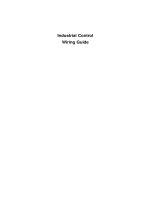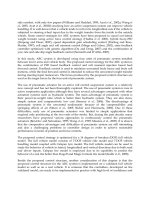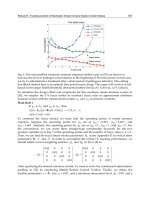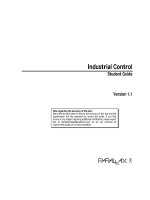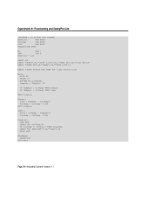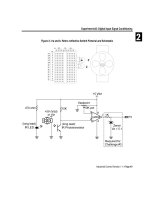Industrial Control Wiring Guide 2E Episode 4 ppt
Bạn đang xem bản rút gọn của tài liệu. Xem và tải ngay bản đầy đủ của tài liệu tại đây (90.86 KB, 10 trang )
3. WIRE TYPES AND PREPARATION
3.7.4. Cable strippers
The outer sheath of multicore cables has to be
removed without damage to the inner cores. There are
several types of stripping tool available and although
the actual detail differs between types, a representative
tool is shown here.
᭹ The cable clamp is spring loaded.
᭹ The cutter is adjustable for the thickness of outer
insulation.
Operation
᭹ Use a spare piece of cable to check
adjustments.
᭹ Adjust the cutter to suit and lock in position.
᭹ Open up the jaw and place it around the cable.
᭹ Squeeze the jaw to cut into the insulation.
᭹ Rotate the stripper to cut the insulation all the
way round.
᭹ Pull off the insulation.
᭹ Check that no inner core is damaged.
24
3. WIRE TYPES AND PREPARATION
3.7.5. Fault prevention
Here are some examples of the damage that can be
caused by lack of care when removing insulation.
᭹ Nicks in solid conductors.
᭹ Stripped plating and scores in solid metal
conductors.
᭹ Strands cut out of multistrand wires.
᭹ Strands nicked.
These cause the wire to be mechanically weakened
and its current carrying capacity reduced.
Each of these has the potential to cause the finished
equipment to malfunction when it is in service,
because the wire will eventually break off or even act
like a fuse.
Summary
Hand strippers are a common cause of damage to insulation and conductors so you must frequently check
the adjustment and, with the so-called automatic type, be sure to use the correct hole size.
It is all too easy to place the wire into the wrong hole, either smaller, causing the damage already
mentioned, or larger, which can tear the insulation leaving a ragged edge which may get mixed in with the
solder and cause contamination of the joint.
Most of these problems can go unnoticed except by you at the time they occur. However, remember that
they will cause operational problems to the end-user, so don’t let them pass.
Whatever type you are using, read the instruction leaflet which the manufacturer provides before using
them. If you use an adjustable type, be sure to adjust it properly and check it regularly in use.
25
4. SOLDERING AND TERMINATION
4.1. Soldering equipment
4.1.1. The soldering iron
The purpose of the iron is to heat up the joint
sufficiently to melt the solder which then flows around
and into the joint to secure and protect it.
᭹ Electric irons are either powered direct from the
mains or use 12 V or 24 V supplied by a
transformer unit.
᭹ A typical low voltage iron is shown. The heated
tip is called the bit or tip and is removable.
᭹ The power of the iron is measured in watts
(W).
᭹ For non-temperature controlled irons, more watts
means more heat.
᭹ The smaller iron is 15 W and would be suitable
for small joints such as printed circuit boards or
small pins and wire. Say 7/0.2 wire soldered to 1
or 2 mm pins.
᭹ The larger iron is about 100W and would be
used for those joints which are larger than
normal. Say tin plate or 4 mm diameter wire to a
suitably large solder tag.
᭹ The temperature of the tip is the most important
factor, so the normal iron is temperature con-
trolled between 250°C and 400°C, and for safety
is powered by a low voltage supply.
᭹ The temperature control may be incorporated in
the base unit and varied by a control knob.
᭹ In other irons the tip itself determines the
operating temperature. To change the tempera-
ture, you change the tip.
᭹ An enclosing holder and a sponge may be
incorporated into the base unit or as a separate
unit as in this example.
26
4. SOLDERING AND TERMINATION
᭹ Tips or bits come in a variety of shapes. All
modern tips are plated to prolong their opera-
tional life.
᭹ The tip must be tinned before being used for the
first time. This simply means melting a little
solder on to it once it is hot enough.
᭹ Use a tip size and shape which will allow the
tinned end to touch both parts of the joint.
᭹ This one is too small and will not heat the joint
enough to melt the solder.
᭹ The sponge is dampened and used to clean the
tip.
᭹ DO NOT use a wire brush or file on plated
tips.
27
4. SOLDERING AND TERMINATION
᭹ When not in use the iron must be kept in an
enclosing stand.
4.2. Solder
᭹ The solder used in assembly work is called
multicored solder since the flux is contained
within several cores in the middle of the solder.
᭹ The flux helps to clean the joint and should
always be non-corrosive.
᭹ The solder itself is an alloy of tin and lead.
᭹ Different ratios are available. 60/40 tin/lead is
the norm.
᭹ Solder comes in a variety of diameters expressed
in the SWG system. 20 SWG is a good starting
point.
4.2.1. Using solder
᭹ Most of the joints you will make will be
connecting wire to pins.
᭹ Practise melting the solder and making a solder
joint using a piece of 22 SWG bare tinned copper
wire.
Apart from the iron and solder, the only basic tools
needed are:
᭹ Wire cutters;
᭹ Smooth jaw, snipe-nosed pliers.
28
4. SOLDERING AND TERMINATION
4.3. Forming the wire
It is essential in this kind of connection to make a
good mechanical joint before soldering. This then
takes any strain rather than the solder having to do so.
The solder’s job is mainly to protect the joint from the
atmosphere.
᭹ The parts to be soldered must be clean and free
from grease. Avoid touching them with your
fingers.
᭹ Place the wire against the pin.
᭹ Use the pliers to form it round the pin.
᭹ Trim off the excess.
᭹ Use the pliers to squeeze the wire across the pin
to hold it firmly.
᭹ You should now have a joint which looks similar
to this.
᭹ The amount the wire is wrapped around the pin
can be anywhere between 180° and 350° depend-
ing upon the application of the finished unit.
᭹ Aerospace and defence work, for example,
requires 350°.
29
4. SOLDERING AND TERMINATION
4.4. Soldering the joint
᭹ Clean the iron tip on the damp sponge.
᭹ Melt a little solder on the tip of the iron. This
helps to transfer the heat to the joint.
᭹ Touch both parts to be soldered – wire and pin.
᭹ Feed the solder in from the opposite side. It will
melt and quickly flow around the joint.
᭹ Remove the solder before the iron.
᭹ It should take about three seconds to heat, melt
and flow.
4.4.1. Checking solder joints
᭹ The outline of the wire should be visible under
the solder.
᭹ The soldered joint should be shiny and the solder
outline should be concave.
30
4. SOLDERING AND TERMINATION
᭹ This joint is not covered. There is not enough
solder. Reheat and put more on.
᭹ There is too much solder here. Use a desoldering
gun to remove all the solder then resolder the
joint.
4.4.2. Soldering stranded wire
᭹ Before connecting stranded wire to a connector it
must first be stripped, twisted and tinned.
᭹ Use pliers to twist the strands or use the method
described in the section on insulation removal,
using the insulation stub.
᭹ Steady the wire and apply a light touch of solder
to the strands.
᭹ The tinning should stop just short of the
insulation.
᭹ The outline of the strands should be visible.
31
4. SOLDERING AND TERMINATION
᭹ Too much solder and the wire is impossible to
form.
᭹ The insulation is also melted into the solder
causing contamination.
᭹ This view shows wicking and is caused by the
solder running up inside the insulation. This
stops the wire being flexible at the joint and it
will probably break off after a time.
4.4.3. Checking your soldering iron
You should carry out the basic checks every day. With
the iron unplugged and cold, inspect for:
᭹ Damaged cables – on the iron or the power
unit.
᭹ There should be no splits, cuts or burn marks.
᭹ No loose or broken cable clamps, on the iron or
the power unit.
᭹ Check the condition of the tip.
᭹ There should be no pits or holes in the plating. If
it is damaged then it will need to be replaced.
᭹ To ensure that the temperature of the tip remains
under tight control it is necessary to rotate the tip
in its holder – preferably twice a day.
᭹ Reseating the tip in this way will clean up the
contact between the element body and the tip,
ensuring good thermal contact and heat flow.
Find out how to do this on your iron.
᭹ Quality standards such as BS 5750 require that
tip temperatures should be checked at regular
intervals and normally this will be carried out by
your supervisor or a member of the quality
control team who will keep records.
32
4. SOLDERING AND TERMINATION
Summary
Soldering
᭹ Remember. Soldering takes much practice.
᭹ Allow the iron to heat up and stabilise before
you use it.
᭹ Wet the cleaning sponge.
᭹ Make sure that the surfaces to be soldered
are clean and free from grease. The solder
won’t take properly otherwise.
᭹ Use non-corrosive flux-cored solder.
᭹ Make a mechanical joint before soldering.
᭹ Apply the iron tip to heat both parts of the
joint.
᭹ Melt the solder on the joint not the iron.
᭹ The wire outline should still be visible under
the solder.
᭹ Check your iron daily for signs of damage –
when the iron is cold!
᭹ Clean plated tips on a wet sponge only.
᭹ Make sure the sponge is kept wet.
᭹ Never file plated tips.
᭹ Always replace the iron in its stand after use.
᭹ Rotate the tip at least once a day if in
constant use.
4.4.4. Safety aspects of soldering
᭹ Molten solder can easily burn flesh and cause serious damage to eyes should there be direct
contact.
᭹ The soldering tip will burn skin and clothing.
᭹ Keep the iron in an enclosing holder when not being used.
᭹ Always use the damp sponge to clean the tip – never flick the iron.
᭹ Protective clothing, when instructed, should be worn.
᭹ Find out where the First Aid box is, including eyebaths, which should be available in the
workplace.
᭹ Most irons are 12 V or 24 V powered and are therefore relatively safe from the electric shock point
of view.
᭹ Mains-powered types must be earthed to the line earth and checked frequently for damage likely to
cause a shock hazard.
33

